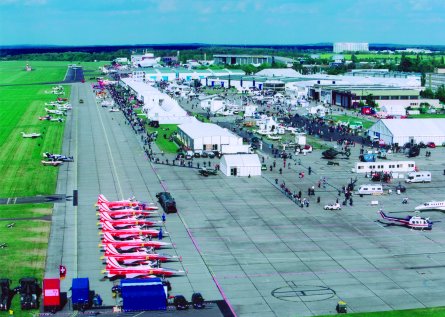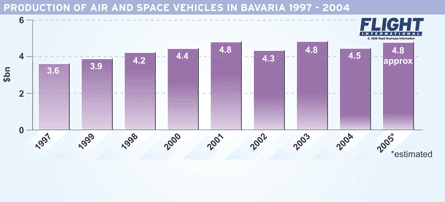Murdo Morrison / London with additional reporting by Andrew Doyle and Helen Massy-Beresford
 |
| While ILA has never had the stature of farnborough, its organisers are sensitive to accusations that it is a "Germany-only" show |
Germany’s once-powerhouse economy may have languished in recent years, but its aerospace suppliers are continuing to reap the benefits of a growing global market for civil aviation as they prepare to gather for their “home” air show – ILA in Berlin – next week. While the country’s growth rate last year was a meagre 1%, revenues generated by the aerospace sector soared by more than 16%, says industry association BDLI. Employment rates in Germany failed to budge in 2005; in civil aerospace jobs grew by almost 16%.
Despite a defence budget that has been shrinking or at best static since the end of the Cold War and a precarious start to the 1990s, Germany’s aerospace industry has been in bullish form for 10 years, with only a short blip in 2001. Industry turnover has increased from €7.85 billion ($9.68 billion) in 1995 to €18.6 last year, says BDLI. The main contributor to that success has been Airbus, which has been boosting output year on year virtually throughout that period.
Employment
The manufacturer’s Finkenwerder, Hamburg plant – where final assembly of the A318, A319 and A321 takes place, and large subassemblies of every Airbus aircraft are manufactured – employs 11,000 people. Around 70,000 others work in the industry, many in the Airbus supply chain, but also at large services providers such as Hamburg-based maintenance and overhaul specialist Lufthansa Technik, which has a staff of 7,000, engine manufacturers MTU and Rolls-Royce Deutschland, and EADS, the German government’s national defence and space “champion”.
The country also has arguably Europe’s most diverse general aviation sector, with manufacturers including Grob and Extra, engine-maker Thielert and MT Propeller. Hamburg and Bavaria are the main two aerospace regions, with sizeable pockets of industry in Berlin, Bremen in the north west, Dresden in eastern Germany, and around Friedrichshafen in the south.
ILA, which takes place at Berlin’s Schonefeld airport from 16-21 May, and organised by BDLI, is – among other things – the German aerospace industry’s “window to politics”, according to the association. With large numbers of politicians and officials from the defence, economics and industry ministries attending the show, it gives industry an opportunity to get across key messages, says Stefan Berndes, responsible for the civil aviation and small manufacturing sectors within BDLI. This year is particularly key as parliament will be debating during the show the proposed budget from the new “grand coalition” administration headed by Chancellor Angela Merkel, aimed at kickstarting the ailing economy. It includes a provision for €285 million funding for aeronautics research.
The German aerospace industry will be keen to make the point that it is bucking the trend in the manufacturing sector but – despite spending €3 billion or almost 16% of its turnover on research and development – needs support from the government if it is to continue to make progress, says Berndes. “We need to renew the German economy,” he says. “The key to that is innovation. We as aerospace are able to deliver an important contribution to this project, as we are high-tech and with very strong growth rates. But, it is important to support R&D early in the cycle, because it can become underinvested if you don’t put public money in.”
Eastern bridge
While ILA has never had the profile of its UK rival Farnborough, held just a few weeks later in July, BDLI is sensitive to accusations that it is merely a “German” national air show. It insists it remains one of the “big five” global air shows with Paris, Farnborough, Singapore and Dubai, and has a number of “unique selling points”. These include its role as a bridge for Russian and eastern European industry establishing links with Western counterparts, its extensive conference programme – with around 80 events – and its long heritage: the first ILA was held in 1909, making it the oldest air show in the world.
This year, BDLI says ILA will break the 1,000 exhibitors mark, making it bigger than the record set in 2000. And, although the show is a platform for Germany’s army of small and medium-sized engineering companies to display their wares and competencies to buyers further up the supply chain, it has also been successful in attracting large overseas contingents, particularly from eastern Europe and North America.
Russia’s about-to-be-restructured aerospace industry will be there in strength, filling 1,500m2 (16,000ft2) in Hall 10 and ILA’s largest-ever representation by a foreign country, says BDLI. Exhibitors include Beriev, Irkut, Kamov, Kazan, Mil, Rosoboronexport, Rostvertol and Sukhoi. The country’s industry presents a “huge opportunity” for partnership, says Berndes, with several German-based companies, including Diehl, EADS and Liebherr, already establishing manufacturing links with Russia.
Eastern Europe may not have proved to be the gaping new market for German industry that some were predicting when the country reunified in 1990 (the costs involved in integrating the dysfunctional economy of the old East Germany has arguably been a factor in the country’s relatively poor recent economic performance).

However, many believe that there are now real opportunities for aerospace as the accession of eight formerly Communist countries to the European Union makes it easier for German companies to sell or set up lower-cost manufacturing businesses there. Russia looks promising on several fronts, says EADS. The country’s ageing domestic airliner fleet means there is pent-up demand for new-generation aircraft, either Western types or home-grown aircraft built in partnership with the West.
Russia also has thousands of experienced engineers and designers and the skills shortage in Germany and elsewhere in western Europe is partly why Airbus and EADS are among those to have set up research and engineering facilities in the country. “It is a very attractive and interesting market,” says an EADS executive. “That is why we, and so many others, are going there.”
Military on show
Germany’s military aviation sector – which, according to BDLI is responsible for 17,200 jobs and a turnover of €5.4 billion – will also be well represented at ILA. The armed forces will be displaying their latest acquisitions, including the NH Industries NH90 transport helicopter, Eurocopter Tiger UHT attack helicopter and Eurofighter Typhoon. Other military hardware making an appearance includes the Boeing Apache Longbow and the vectored-thrust MiG-29. Enthusiasts will be able to see a rebuilt Messerschmitt 262 fly.
Declining post-Cold War defence spending in Europe helped send Germany’s aerospace industry into freefall in the first half of the 1990s and was one of the main reasons EADS was created towards the end of the decade. “We realised that we could not be so dependent on national defence budgets,” says the company. Despite Germany’s increasing involvement in overseas peacekeeping missions in recent years, few expect spending in the country to rise significantly. And although ILA presents Germany’s defence players an opportunity to showcase capabilities and maintain contacts with government customers, EADS is increasingly setting its sights on establishing a footprint for its defence business in the USA and UK, the biggest spender in Europe.
Headlining the civil aircraft cast at ILA will be the Airbus A380, making its ILA debut, though not – as was hoped by some – in the colours of one of its early customers, German flag carrier Lufthansa, despite the appearance of Emirates- and Singapore Airlines-liveried A380s at their recent “home” shows. Airbus’s contingent also includes the A340-600 and Hamburg-assembled A318. The Eurocopter AS350 will be among the civil helicopters on display, along with around 50 aircraft from the likes of Agusta, Bell, MD Helicopters, Poland’s PZL Swidnik and Sikorsky. The HeliCenter has its own hall with a heliport next to it and its own row of chalets.
Despite the proximity of the EBACE European business aviation show in Geneva just two weeks earlier, ILA, say the organisers, is one of the largest trade fairs in the world for business, private and sports aircraft. A “general aviation avenue” will play host to aircraft from Acquila, Beechcraft, Bombardier, Cessna, Cirrus, Diamond Aircraft, Embraer, Extra, Pilatus, Piper and Socata.
Spaceflight will be another prominent theme, with Hall 9 dedicated to the sector. The Bremen-built upper stage of Ariane 5 is on display for the first time and the Chinese and Ukrainian space industries will be represented. In Hall 10, Russia’s space industry will have its biggest display at any show outside Russia, say the organisers.
Exhibits will include models of the Glonass-M navigation satellite and the proposed Kliper reusable manned spacecraft, as well as the International Space Station and Resurs-DK1 Earth observation satellite.
Image problem
German aerospace is, despite its recent successes, suffering from an image problem – at least as far as young would-be professionals are concerned. A shortage of engineering graduates has been prompted in part, says BDLI’s Berndes, by the 1990s downturn that shattered the expectation by many that Germany’s industrial giants offered a job for life. Now, BDLI says it wants to “send a signal to the community” that a growing sector provides good career opportunities for youngsters. This year for the second time, ILA will feature a career centre, with presentations on 19 and 20 May from, among others, Aerotec, Airbus, Brunel, EADS, Lufthansa Technik, MTU, Rolls-Royce and Ryanair.
Another new feature this year is an International Suppliers Centre, where small companies will be able to meet would-be customers and hear presentations from large manufacturers on their new programmes and future expectations.
Finally, ILA organisers boast “the most wide-ranging programme of conferences ever provided at a trade fair”. Among 80 subjects covered in 80 events are unmanned air vehicles, aeronautic research, general aviation, military maintenance, defence and space, military pilot training, border protection, global security, and aerial reconnaissance.
Source: Flight International























